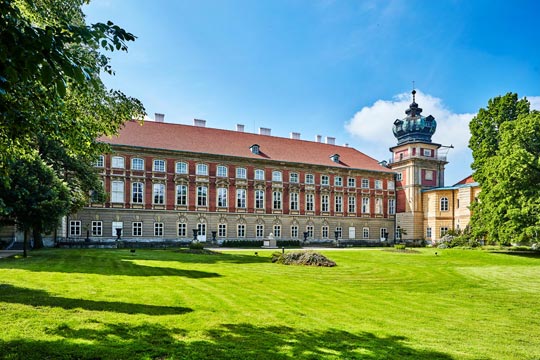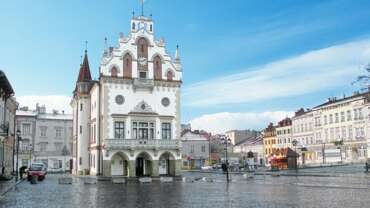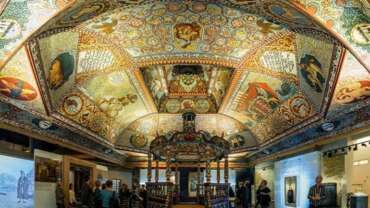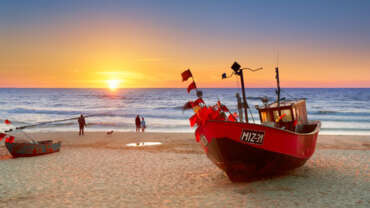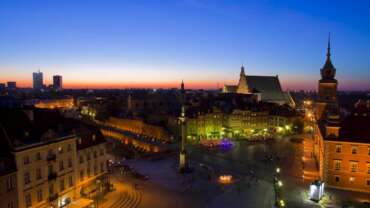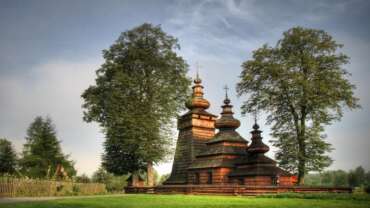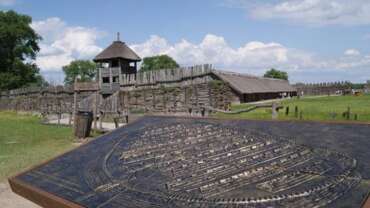Castles & Palaces in Poland
After countless wars, partitions and other political and social turbulences, the preserved and restored castles and palaces are now part of Poland’s historical heritage. Priceless monuments of the past remained untouched in many places. Others were restored or reconstructed with such meticulous care that they became works of art no less important than the original structures. By far, the boldest such undertaking was the reconstruction of the Royal Castle in Warsaw. Whether preserved or restored, castles and palaces are full of life these days. They are homes to museums and/or education centers. They are venues for cultural events or outdoors events. They have been converted into luxury hotels with spa facilities. While restaurants in castles and palaces take you on journeys to the times of hunters’ parties and opulent feasts of the Polish nobility.
Many layers of history are still waiting to be discovered. They are hidden in strongholds, in the Teutonic Knights castles, or in castles constructed by aristocrats to become family residences. Mysteries also remain to be uncovered in royal castles, late Renaissance family residences and in exuberant palaces of most exquisite designs. Palaces were often surrounded by sumptuous parks, French or English gardens, frequently with romantic or downright fairy-tale gazebos and pavilions. And so they remain to this day.
And there are plenty of stories to be told, some are facts, other just the legends but they always belong to a place. The treasure hunters must visit Ksiaz Castle – the largest fortress in Dolny Slask where the train full of stolen gold is hidden. Ghost lovers should visit castles in Checiny or Niedzica. The ruins of the largest caslte Krzyztopor in Ujazd will tell you the story of falling fortune. And we could go on for hours because there are over 500 castles and 2,5 thousand of palaces scattered all over Poland, but instead join us for a tour.
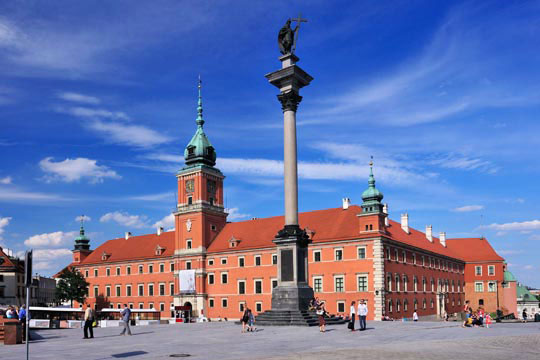
ROYAL CASTLE IN WARSAW
Former residence of Mazovian princes. Once the capital was moved to Warsaw from Krakow, the castle served as seat of the king and the government. Completely destroyed during World War II.
Built in the 15th century, this castle served as residence of Mazovian princes. Once the capital was moved to Warsaw from Krakow, the castle served as seat of the king and the government. The castle has been renovated repeatedly and destroyed completely during World War II. It was rebuilt between 1971-1988 using castle remains and rubble. Today, the segment with the clock tower opens the way to the Old Town. Museum attractions include two original Rembrandt paintings as well as works by Bernard Bellotto, aka Canaletto, court painter to Polish King Stanisław August Poniatowski. Canaletto’s paintings were vital during Warsaw’s post-war reconstruction.
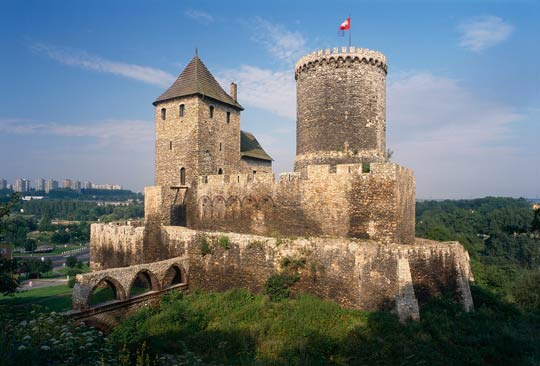
THE BEDZIN CASTLE
The Bedzin Castle is a castle in Bedzin in southern Poland. The stone castle dates to 14th century, and is predated by a wooden fortification that was erected in 11th century. It was an important fortification in the Kingdom of Poland.
The site of Bedzin Castle was in earliest known a 10th century grod, subsequently destroyed in the 12th century. In 1228 a wooden castle with stone foundations and a stone tower was on the hill by King Boleslaw the Bashful, but it was burned by the Mongols in 1241. It was rebuilt in wood, but in 1358 Casimir the Great (1333-1370) replaced the mainly timber structure with the current masonry castle. The old stone watch tower was heightened, apparently to twice its current height, and a large square keep served as the royal residence. The inner curtain walls were 26 to 39 feet tall. A 16 foot tall outer curtain formed the middle ward. There are etchings of an outer ward with two entrance gate towers on the internet, but I’ve seen no sign of ruins. A stone wall protecting the town was added six years later, some of which remains.
Bedzin is located between Katowice and Krakow on the main road leading from southwest Poland into Silesia, which was for centuries at the edge of the Holy Roman Empire and for a time was part of Prussia. Casimir’s castle was built to protect the border of Poland from the incursions of the Germanic Silesians. It was an important market town, enhanced by the salt trade. The Swedish invasions of 1655 partially destroyed the castle, but it was rebuilt in 1855 by Francisco Maria Lanci, who lowered the tower. The town of Bedzin is frequently sadly remembered for the vibrant Jewish community that was destroyed in 1939. The Nazi SS destroyed the synagogue and eventually transported almost 10,000 Jewish citizens to Auschwitz for extermination. The castle’s last major restoration took place in 1956 – it now houses a very popular museum. The current population of Bedzin is about 60,000.
The castle became the site of a museum, Zaglebie Museum in 1956. The museum has several collections: one of armament, from medieval to World War II times; second dedicated to the history of the Będzin Castle; third to the castles of the other nearby castles founded by Casimir the Great (Eagle Nests Trail or Szlak Orlich Gniazd) and the final one, to the military history of the Bedzin region.
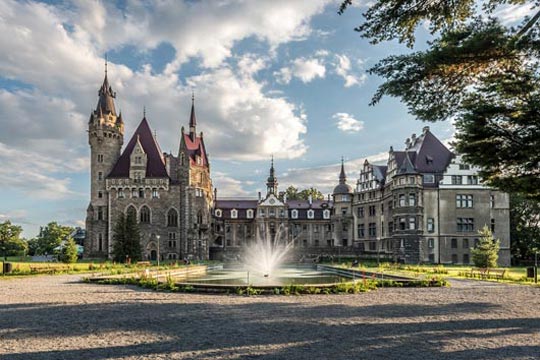
THE CASTLE IN MOSZNA
The castle in Moszna is one of the best known monuments in the southern Poland. The castle and park complex is the former residence of the German Tiele-Winckler family. This gigantic 7,000 square and 65,000 cubic meter construction was started in the 17th century. It contains 365 rooms and 99 turrets. It is reminiscent of English castles from the Elizabethan period. The stud farm with thoroughbred Arab horses attracts many enthusiasts of equestrian sports.
Apart from the castle itself, the entire complex includes a park which has no precised boundaries and combines with the nearby fields, meadows and a forest. Only the main axis of the park can be characterised as geometrical. Starting from the gate, it leads along the oak and then horse-chestnut avenues, towards the palace. Further on, the park passes into an avenue of lime trees with symmetrical canals running along both sides of the path, lined with a few varieties of rhododendrons. The axis of the park is ended in the base of a former monument of Hubert von Tiele Winckler. On the eastern side of the lime avenue there is a pond with an islet referred to by the owners as the Easter Island. The islet is planted with needle-leaved shrubs and can be reached through a Chinese-styled bridge. The garden, being a part of the whole park complex, was restored slightly earlier than the castle itself.
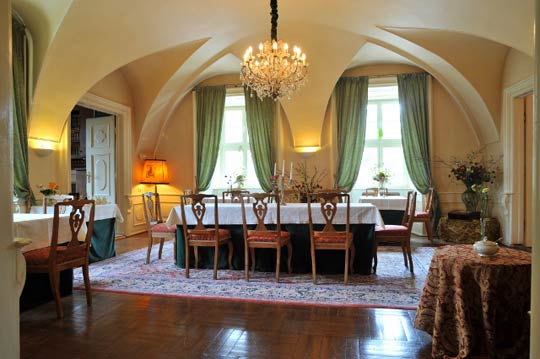
THE STANISZOW PALACE
Staniszow, thanks to its location and great care of the local residents, was claimed to be the most beautiful village in The Valley of Jelenia Gora until the end of the Second World War. The words of Isabela Czartoryska, who visited Staniszow on her way to Cieplice, can confirm that opinion: “… and then we went to Staniszow. The village belongs the earl Reuss, we found there the same taste we had been admiring in Grodna. The nature is beautiful and the location enchanting. Nothing has been spoiled and all that is handmade seems to be the work of Nature”.
There were 3 estates, which made up a dominion of Reuss line, with the abode in Upper Staniszow. The old line of Reuss descended from Saxony. Heinrich der Fromme von Weida was the progenitor of the line and the younger Reuss generation became the owners of Staniszow. The Palace was built in 1784-1787 on the earl Heinrich XXXVIII von Reuss initiative. The great location and a picturesque landscape park made the Palace one of the most beautiful estates in the Valley of Jelenia Gora. The park and forests occupied an area of 194 ha. In addition, there were artificial ruins of a nineteenth-century castle which contained a hunting room, an artificial grotto, a hermitage, hanging rocks, vast meadows and breathtaking views on Karkonosze and the Valley of Jelenia Gora. All of that changed the park into the most favorite place for trips for the villagers, the Palace’s guests and tourists who were staying in the area. The park itself, despite having been a private property, was incessantly opened for the guests from the outside.
The palace and park layout was thoroughly restored between 2005 and 2008. These works constituted one of the widest restorations of the palace complex in Poland. Not only had the former neo-Gothic palace regained its previous brilliance, but also all buildings of the old manor farm and the Romantic landscape park. The stable, granary, outhouse, coach house, and barn completely changed their original functions. Now they are the seats of an exclusive hotel including a conference room, recreation facilities, two restaurants, a café, wine bar, garden bar, tea room and offering 200 beds of various standards.
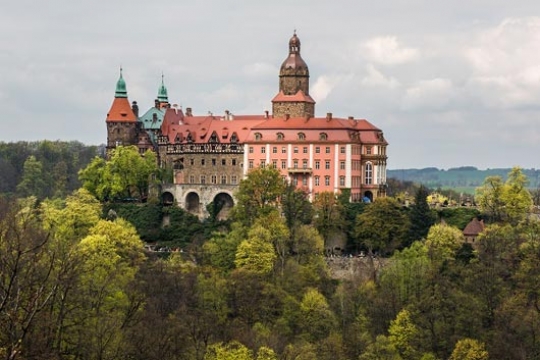
KSIAZ CASTLE, THE PEARL OF LOWER SILESIA
Constructed in the 13th century, Ksiaz castle was home to many noble families such as the mighty House of Hochberg. Between 1509 and 1941, the Hochberg’s expanded the castle and significantly contributed to its splendor. During the World War II the castle was taken over by the occupying German forces. Under their reign numerous historic chambers were destroyed. The Nazis created a system of tunnels underneath the castle, which the function still remains a mystery. Recently the Ksiaz castle made news as a rumor of a lost Nazi gold train was believed to be buried in the vicinity of the castle.
After systematic looting committed by the German occupiers and later by the Red Army, in 1952 the renovation work was undertaken to restore the Ksiaz Castle to its previous grandeur.
Today, visitors can admire the majesty of numerous chambers, terraces and surrounding gardens. The underground tunnel is also available to the public. Those visitors wishing to spend a night, Ksiaz Hotel is conveniently located nearby the castle.
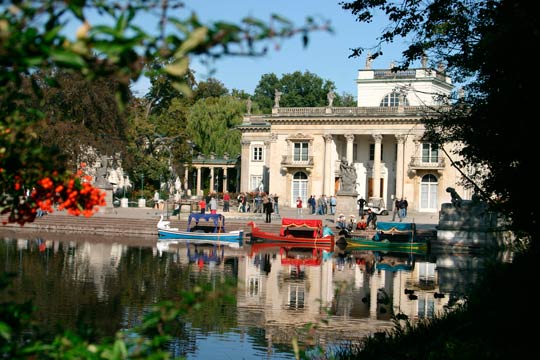
LAZIENKI PALACE
This is the biggest and most beautiful park in Warsaw, and one of the loveliest palace/ park locations in all of Europe.
Łazienki Park, the favoured residence of Polish royalty, was constructed between 1774-1784, at the command of King Stanisław August Poniatowski. Stanislaw August was a great patron of the arts, and this is reflected in the sumptuous interiors of the main palace. A good deal of the monarch’s original collection has survived. Lazienki Palac stands over 76 hectares, and combines elements of a traditional French garden within the landscape of a classically English park. This is the centre of numerous natural, cultural and scientific events and sources of entertainment, and is a much-loved place for residents and tourists alike to stroll.
The palace is built on an artificial island that divides the lake into two parts, a smaller northern lake and a bigger southern lake; it is connected by two Ionic colonnaded bridges to the rest of the park.
Palace on the Island
The most significant building in the garden, a pearl of Polish architecture and one of the capital’s symbols. It came into being when the last Polish king, S. A. Poniatowski, expanded a small building known as Lubomirski’s Bath into one of his residences. Despite being badly damaged, the Palace survived World War II and was re-opened in 1960.
Myślewicki Palace
This palace is located at the end of the road leading from the city. It was designed in an early Classicist style and is one of Warsaw’s few remaining examples from this architectural era.
White House
The building is an original memento from the time King S. A. Poniatowski — although devastated, it wasn’t entirely destroyed during World War II. Preserved, original interiors include huge paintings in the dining room, original Chinese wallpaper in the drawing room, an office decorated with paintings and the King’s original bed in the bedroom.
Old Orangery
The east wing features a beautiful interior, including one of the world’s few examples of an authentic court theatre.
The west wing has servant living quarters and guest rooms.
Podchorążówka
This building made its mark in Poland’s history — it was here that P. Wysocki urged cadets to pick up their weapons and revolt, beginning the November Uprising. Podchorążówka currently host the I. J. Paderewski’s Museum of Polish Emigration. Its collections are associated with Poles around the world.
Amphitheatre
Built on the bank of the pond, this structure is based on buildings that once stood in this exact spot. The audience area is reminiscent of the theatre in the Herculaneum — it has statues of famous dramatic writers around its top and the stage resembles the Roman Forum. The most unique feature of the Amphitheatre is the fact that the stage is separated from the audience by water.
Pavilions in the Park:
Hermitage
A small building that currently houses a gallery with temporary exhibitions. Concerts and meetings with authors and artists are hosted here.
Egyptian Temple
Built in the 19th century, but the current remains are only a part of its original structure. In the past, the main part of the building was a glazed conservatory containing fig trees. This building currently houses the Museum of Scouting.
New Orangery
Constructed in 1860, the New Orangery was used in winter to maintain the palace’s exotic plants. It currently hosts a permanent garden and the Belvedere Restaurant.
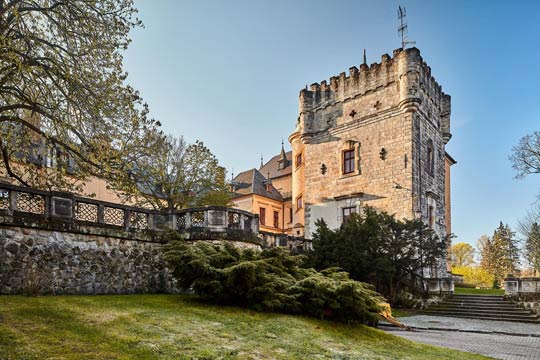
KLICZKOW CASTLE
In the heart of Lower Silesia you will find stylish Neo – Renaissance Residence: Kliczkow Castle Conference and Leisure Centre. The splendid interiors of Kliczkow Castle have been carefully renovated to encourage our guests to immerse themselves into the atmosphere of the past.
In the heart of Lower Silesia you will find stylish Neo – Renaissance Residence: Kliczkow Castle Conference and Leisure Centre. The splendid interiors of Kliczkow Castle have been carefully renovated to encourage our guests to immerse themselves into the atmosphere of the past.
The Castle has been thoughtfully designed to allow suitable accommodation and space for all guests. We dispose of 89 stylish rooms, 6 conference halls, restaurant, orangery and bar.
The castle’s location among the Lower Silesia Forests and close proximity to great monuments creates the unique conditions not only for different types of conferences, seminars or meetings but also for rest and recreation. It is a perfect place for cycling, long walks and carriage rides. In winter, Kliczkow Castle organizes sleigh rides with the flaming torches and after it magnificent fireplace.
Guests can also find here a riding centre with the horseback riding school, tennis courts, swimming pool and sauna.The perfect occasion to biological regeneration gives you Spa & Wellness Centre in Kliczkow Castle. It offers a wide variety of treatments for body and mind.
Additionally, Kliczkow Castle organizes series of entertainment offers called the “Four Seasons” and what is more it is a place of International Festival Wratislavia Cantans.
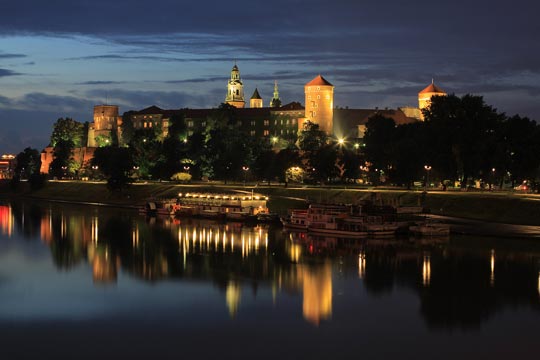
WAWEL ROYAL CASTLE IN KRAKOW
Wawel is a limestone hill in the centre of Krakow upon the Vistula River with a complex of impressive historical monuments of unique historical and artistic values. This extraordinary sanctuary determines the Poles’ identity, is their national and cultural symbol. Wawel used to be the seat of Polish rulers, their necropolis and place where the Polish history took shape.
The oldest ruler’s seat was established at Wawel in the 1st half of the 11th century during the rule of Boleslav the Brave and Mieszko II. The pre-Romanesque complex of prince’s residence was located in the highest south-east part of the hill. It included the residential building, the palace hall, the building with a corridor (cellar) and the Rotunda of St. Felix and St. Adaukt, the best preserved example of the pre-Romanesque architecture in Malopolska.
In the 2nd half of the 11th century the main building of the Romanesque palace complex, the two-storey hall of 24 pillars was erected. The remains of this structure were discovered under the northern wing of the present palace. The main palace church in the 11th and 12th century was the Romanesque basilica of St. Gereon (St. Mary of Egypt) revealed under the western wing of the palace and the Batory’s Courtyard. Nowadays works are in progress to set up an architectural reserve at that site. The Church of St. Mary of Egypt was a three-aisle building with a transept, an eastern crypt and two towers in the west. It functioned till the end of the 13th century.
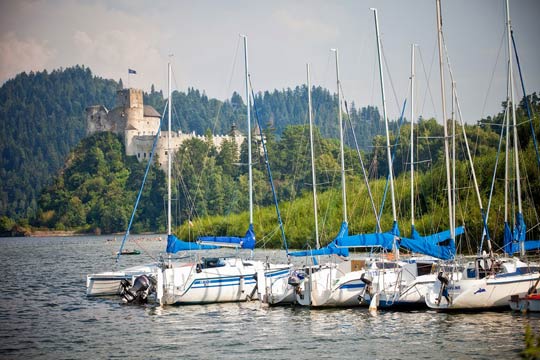
NIEDZICA CASTLE
The castle holds secret treasures, ancient artwork, and the ghost of a woman who appears nightly. Along the road leading up to the castle is a sign that warns visitors that they are about to enter a haunted location. The castle itself is located on a small peninsula into the river, making it ideal to defend against any sort of threat. The castle that stands today was originally built in 1325 by the Brezevichy family.
There was a castle before this one, and it was named Dunajec Castle. It had about several owners in its existence, and there are now only walls that mark the original structure. The ghostly legends at the castle originate from one of the first owners of the castle, Sebastian Brezevichy. He traveled to Peru in South America, and he went on to marry a woman named Umina, who was an Inca royal. When war broke out between Spain and Peru in the 1860s, the Brezevichy family moved back to Niedzica, Poland. They brought along with them the Inca treasure of the family so the Spanish would not be able to take it.
The legend says that Umina was murdered in front of the castle by a treasure hunting thief, and the ghost of Umina appears every night to scare away anyone who comes close to the castle in order to protect her gold. Umina’s father hid the treasure and he created a cryptic document so the treasure can be found again one day. However, no one has been able to break the code of the document up until this point. Umina is referred to as the “White Lady” of Niedzica Castle. Today the castle serves as an archaeological museum with suites that can hold up to 35 guests.
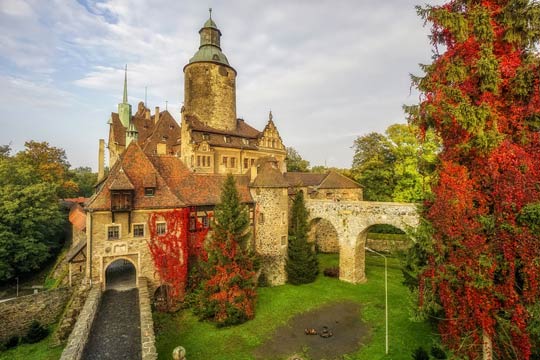
CZOCHA CASTLE
The castle was designed as a fortress in the 13th century. After centuries of political turbulence, followed by a fire which destroyed the castle in the 18th century, the construction was restored to its former glory, owing to ample funding. Thus, it became one of the most interesting landmarks of Lower Silesia.
Unfortunately, aft er the Second World War, almost all the furnishings fell victims to looters. Nowadays, the impressive monumental stronghold is home to an elegant hotel and its historic interiors can be visited like any other museum. Knights’ tournaments, dance shows, comedy acts and concerts organised here add to the appeal, along with a stylish café and a restaurant specialising in Polish cuisine. The castle grounds have also been used as the set for many feature films and documentaries. The castle’s wine cellar hosts mead-tasting events, promoting this drink so strongly connected to the culture of old Poland and appreciated by gourmets.
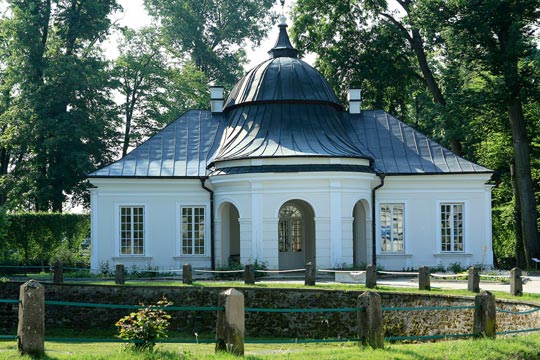
KUROZWĘKI PALACE
At the turn of next centuries the castle was rebuilt several times and given representative character finally to be converted at the end of the 18th century from an originally dwelling building with a defensive character into a Baroque and Classicistic residence. Presently you cannot miss the castle edifice located in the complex of park and palace with its richly decorated five-axle fa˜ade and galleried courtyard. It is worth visiting the interior of the Palace in Kurozwęki with its dungeons and stay for a night in its stylish chambers, hothouse or annex. A unique attraction is a herd of over 80 American buffaloes, which can be admired from the interior of “safari buffalo” carriage. Active leisure lovers may go horse-riding, cycling, play paint-ball or try a rope slide. There are also knight fights, artillery and ancient dancing show organized upon request.
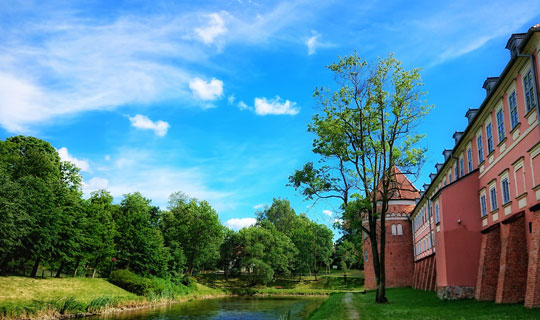
LIDZBARK WARMIŃSKI – A MONUMENTAL MEDIEVAL CASTLE
A part of it, called przedzamcze, contains a Baroque palace. Visitors enter the Gothic, well-preserved castle from the 14th century, by the drawbridge over the moat. Its chapel has opulent rococo interior decorations. Today the castle houses the Warmian Museum with a rich collection of sacral art. On the hilltop stands the neo-classical Bishops’ palace surrounded by a park. Nicolaus Copernicus lived in the castle between 1503 and 1510.
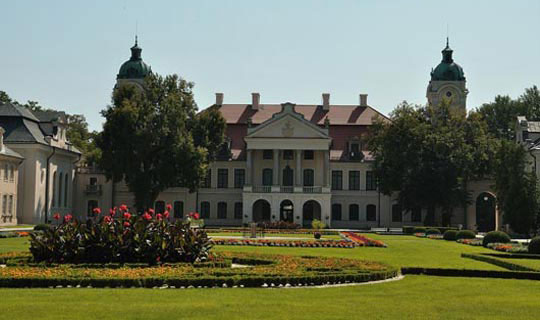
KOZLOWKA – BAROQUE RESIDENCE AND SOCIALIST-REALIST ART MUSEUM
The palace museum features a wealth of diverse objets d’art, and the palace outbuildings house a permanent socialist-realist art gallery. A stroll through the geometric park with the graves of Napoleonic soldiers and a beautiful fountain can be a pleasant experience.
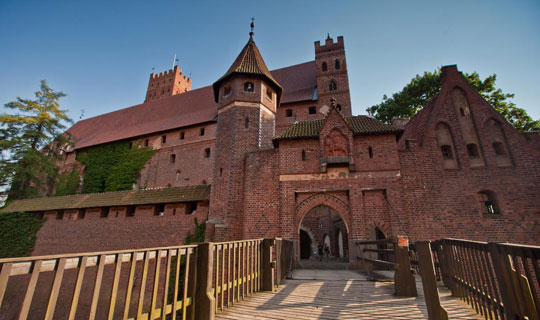
CASTLE OF THE TEUTONIC ORDER IN MALBORK – UNCONQUERABLE FORTRESS
The Malbork castle is the mightiest fortress of medieval Europe. Its construction begun in the 13th century. But major transformation begun in early 14th century, when the Grand Master Siegfried von Feuchtwangen moved his office to Malbork. The castle was promoted to the status of being the capital of one of the most powerful states on the southern coast of the Baltic.
The old structure apparently could not fulfil its new functions in its current form. It took almost half a century to transform a convent house into a strongly fortified High Castle. Surrounded by deep moats and several rings of defensive walls, it housed several representative rooms. Among these are: the church of the Blessed Virgin Mary, enlarged by a new chancel, and St. Ann’s chapel beneath it – the burial site for the Grand Masters. The old settlement outside the outer walls was also expanded, becoming a spacious and functional Middle Castle available to knights – guests from Western Europe.
Apart from living quarters, the Grand Refectory – the largest hall in the castle – was also located here. It was topped with a beautiful fan vault. There was also an Infirmary for the older and sicker brothers, as well as the Palace of the Grand Masters.
In the 14th and first half of the 15th century, a third part of the stronghold was established and expanded respectively – the Low Castle, known later as the Outer Castle. Among other buildings, the Karwan – a large armory for cannons and war carts, a granary on the shore of the Nogat river, as well as a number of outbuildings (a founder’s workshop, the stables, brewery, etc.) were all located there. St. Lawrence’s chapel, intended for the castle’s servants, is located next to one of them. The whole complex was surrounded by moats and defensive walls with countless towers, connected with the fortifications of the city of Malbork.
The best spot to admire the enormous size of the castle is from the Nogat River side.
The Malbork Castle Museum houses numerous exhibitions, to name just a few militaria, amber, china and glass art, furniture and more to discover. One of the highlight of the Malbork Casltle are son et lumière spectacles staged in the evening in the castle courtyards as well as night tours of the castle interiors. The castle chambers often host music concerts and medieval style banquets. In recent years, a great historical event entitled The Siege of Malbork is organized during the last weekend of July.
The Malbork Castle is a UNESCO Heritage Monument and member of the Polish Gothic Castles Association that represents historical buildings located in eight other cities of the region.
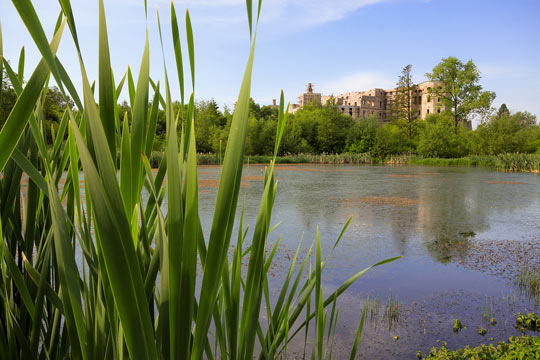
KRZYZTOPOR CASTLE
Krzysztof Ossoliński, the voivode of Sandomierz and a founder of the “palazzo in fortezza” – a palace in the fortress – wanted to impress his contemporaries. Therefore he erected the monumental complex of palaces built in a pentagon bastion fortress modelling on a calendar. The castle had as many windows as there are days in a year, as many chambers as there are weeks, as many rooms as there are months and as many towers as there are seasons of the year. Horses in stables had marble troughs and looked at themselves in crystal mirrors. In one of the rooms an aquarium with exotic fish functioned as a ceiling. Ossoliński spent the amount of 3 million Polish zlotys on the castle with its cubic capacity of 70 000 m3 and covering the area of 1.3 hectares. Presently “Krzyżtopór” Castle ruins enchant with their beauty and magnitude and they once again start to live during numerous tournaments and knight fight shows held there.



